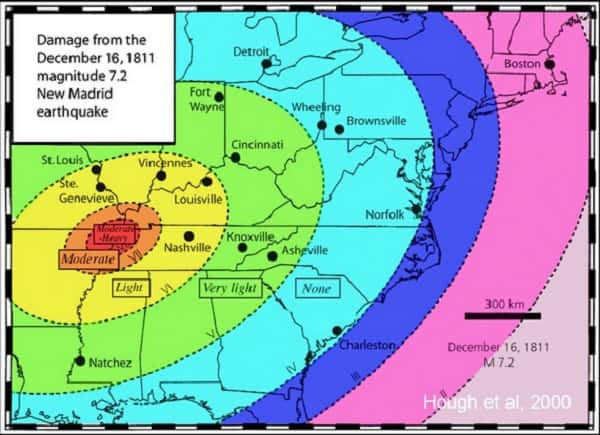
Two centuries ago, a series of giant earthquakes rocked the tiny town of New Madrid, Missouri, collapsing chimneys and shaking houses more than 1000 kilometers away. It was even said that parts of the Mississippi River momentarily flowed backward as the riverbed heaved upward. Modern seismologists estimate that all three quakes in 1811–1812 registered above a 7.0 on the Richter scale—the largest known quakes east of the Rocky Mountains. Even today, the New Madrid Seismic Zone (NMSZ) generates more than 200 small tremors each year.

The threat of large earthquakes striking the New Madrid seismic zone remains all too real for people in St. Louis, Memphis and other parts of the central United States — despite recent reports to the contrary. That is the conclusion of a new study by geophysicists Shelley J. Kenner and Paul Segall published in the journal Science. According to the authors, devastating earthquakes could rip through the New Madrid seismic zone along the Mississippi River sometime this century potentially causing widespread destruction from Arkansas to Iowa. “We can’t say for certain there aren’t going to be any earthquakes in the next few decades,” says Kenner, a postdoc in geophysics at Caltech and lead author of the September Science study. “There was a sequence of large earthquakes in the past, and it could happen again,” adds Segall, a professor of geophysics at Stanford.

Some geologists say there is a 90 percent chance that earthquakes of magnitude 6 to 7 will strike the region in the next 50 years, causing extensive damage and injury — especially in now heavily populated urban areas such as St. Louis and Memphis, which are built along the Mississippi on unstable mud banks. The fact remains that it could happen at any time and there is no way to know when. Increased rumblings on the New Madrid Fault recently has several folks on edge. Sadly, even most Americans that are living in that part of the country don’t really understand how incredibly massive and how potentially destructive this fault zone actually is. Scientists assure us that one day we will once again see very powerful earthquakes along the New Madrid fault. It is only a question of when it will happen. So is there evidence that the New Madrid fault zone is waking up?

Yes, there is. According to Bloomberg, there has been “a sixfold increase in the number of earthquakes that have shaken the central part of the U.S. from 2000 to 2011″. A few people are saying that the small quakes are relieving the pressure and will help prevent a large earthquake. Unfortunately, sometimes the opposite is true. Yes, it is also possible that big quakes can be triggered by smaller ones. … It turns out that sometimes earthquakes are related—small ones can trigger bigger ones—but you have to be careful when you interpret them.

Earthquakes come in clusters; a big quake can be surrounded in time (before and after) by smaller ones. Sometimes a quake can presage an even bigger one. This really is something you need to take seriously. Like with asteroid impacts, if you wait long enough, statistically speaking, your chance of getting hit by an earthquake goes up they occur in all 50 states, and the New Madrid fault which affects seven states in the Midwest and South is a particular hazard.

But, I say again, there is no way to know when the “Big One” may strike. I could be tomorrow or 50 years from now. The best advice is this…If you live near a fault, have an earthquake kit handy. And since there are other natural disasters no matter where you live, everyone should have a kit ready in case of whatever emergency might come along. It can be scary thinking about stuff like this, but it’ll happen at some point whether you plan for it or not. Why not be prepared?






